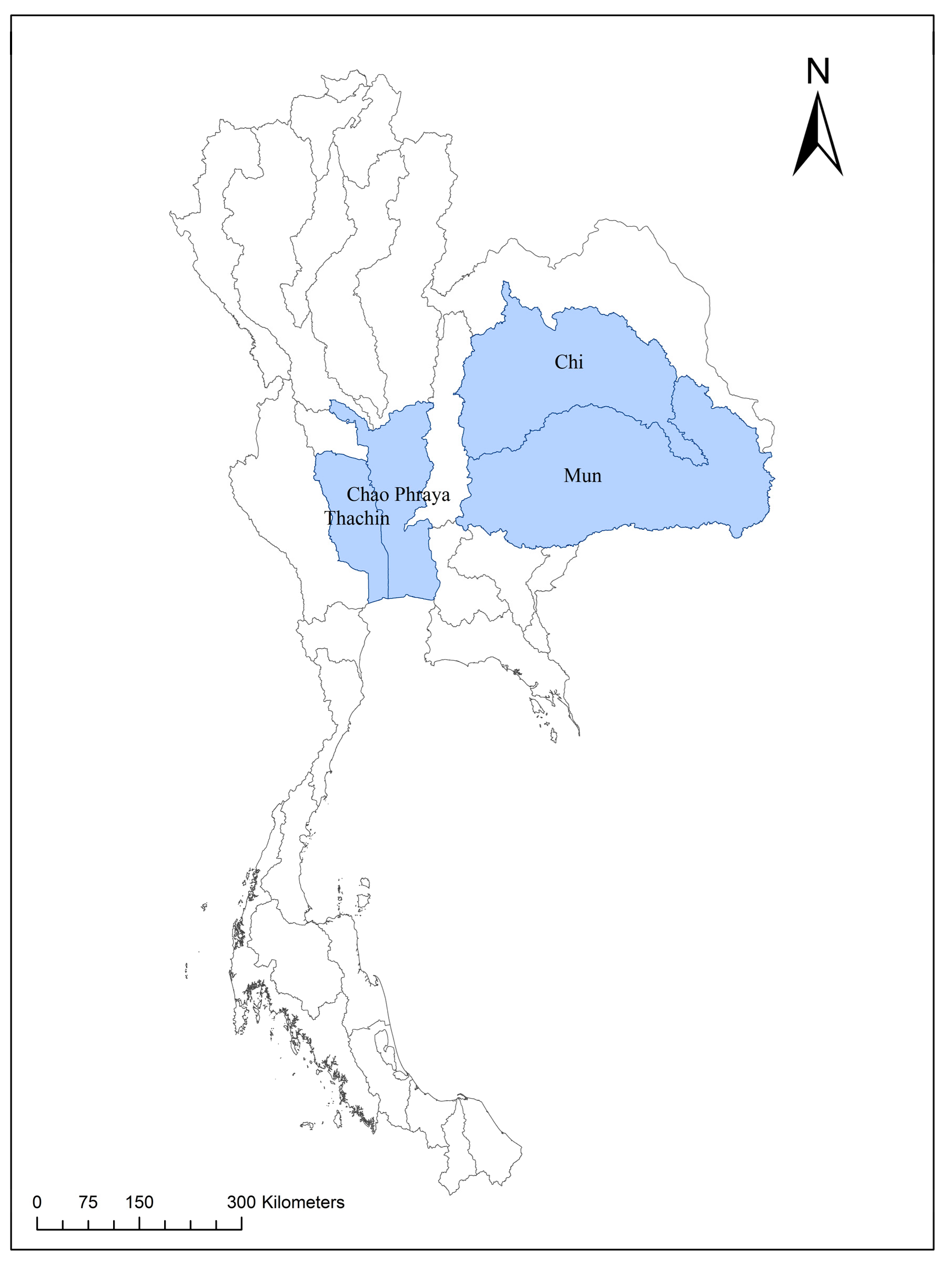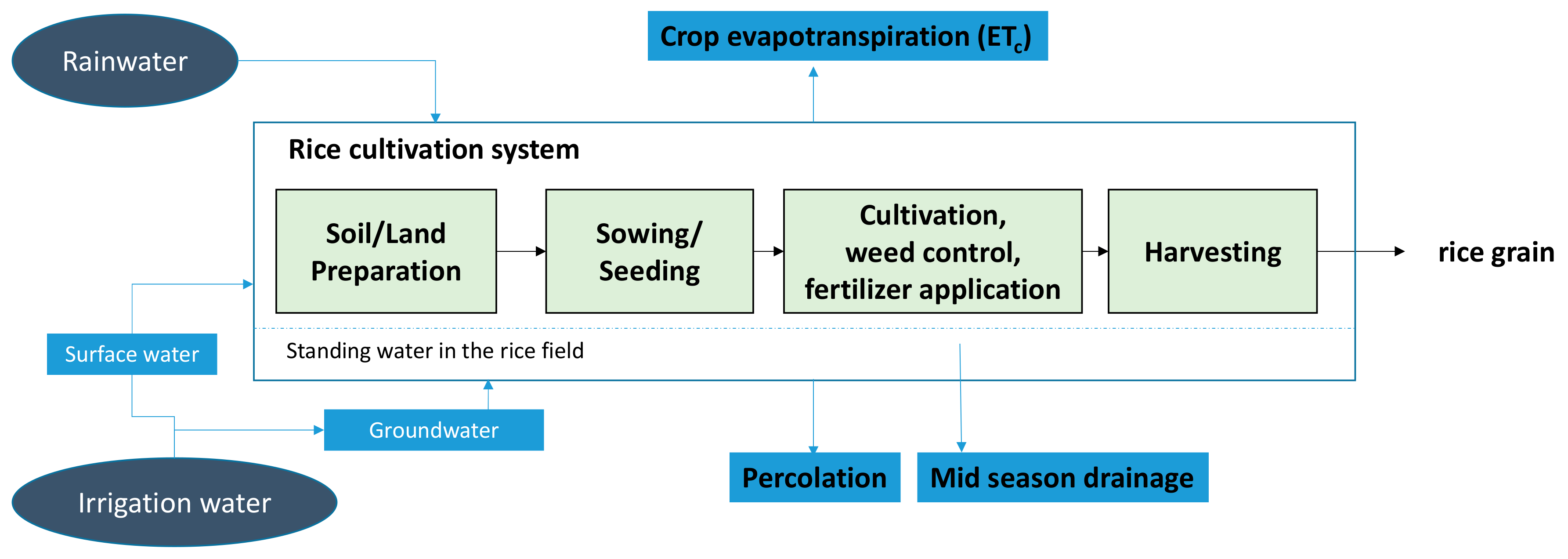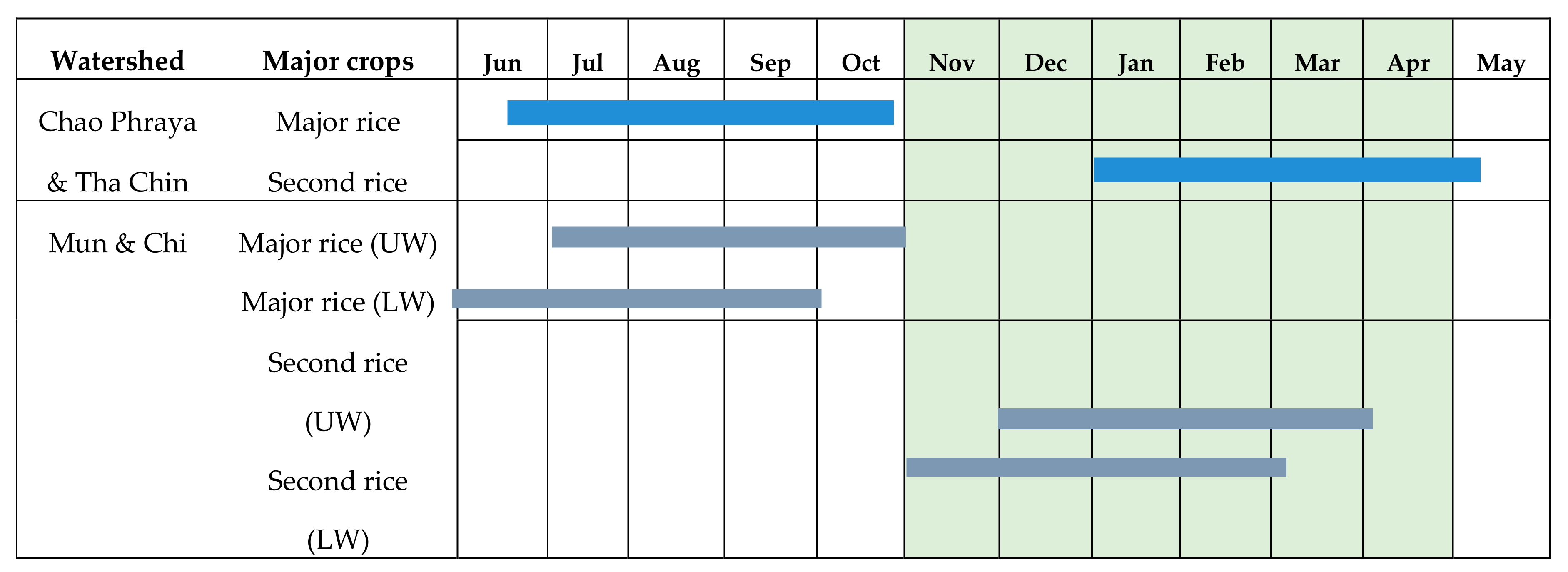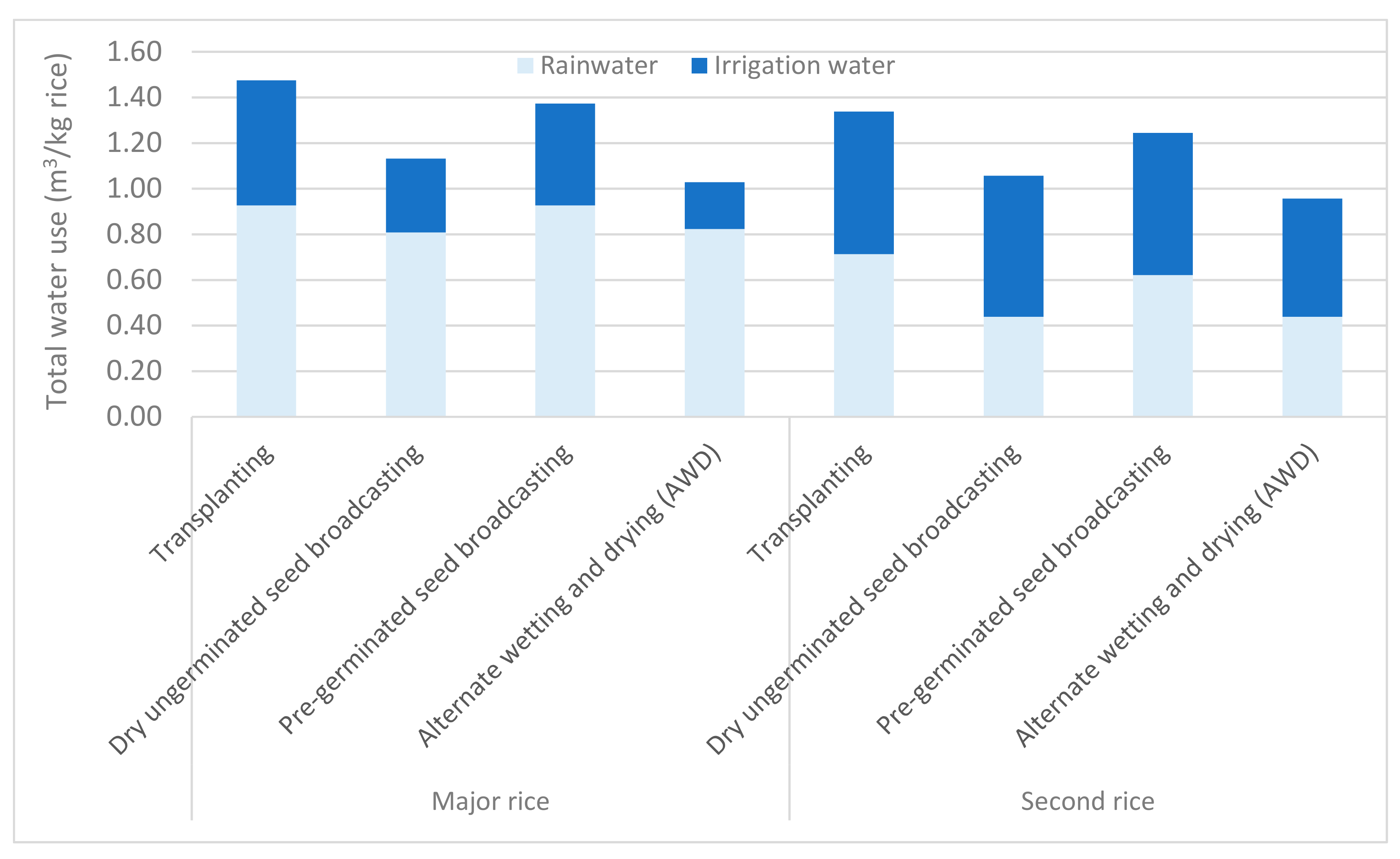Implications of Water Use and Water Scarcity Footprint for Sustainable Rice Cultivation
Abstract
1. Introduction
2. Materials and Methods
2.1. Rice (Paddy) Production in Thailand and the Studied Areas
2.2. Rice Cultivation Systems
2.3. Crop Water Requirement Assessment
2.4. Water Scarcity Footprint Assessment
3. Results and Discussion
3.1. Water Use for Rice Cultivation in Different Watersheds
3.2. Water Scarcity Footprint of Rice in Different Watersheds
3.3. Recommendations for Enhancing Sustainable Rice Production
3.3.1. Improve Water Use Efficiency of Rice Cultivation
3.3.2. Expansion of Irrigated Areas
3.3.3. Agricultural Zoning by Integrating the Water Stress Index
4. Conclusions
Acknowledgments
Author Contributions
Conflicts of Interest
References
- IRRI. Rice Facts. Available online: http://www.sustainablerice.org/Resources/ (accessed on 1 October 2017).
- Food and Agriculture Organization of the United Nations (FAO). Energy-Smart for People and Climate; Issue Paper; FAO: Rome, Italy, 2011. [Google Scholar]
- Hoff, H. Understanding the Nexus. In Proceedings of the Bonn 2011 Conference: The Water, Energy and Food Security Nexus, Stockholm, Sweden, 16–18 November 2011; Stockholm Environment Institute (SEI): Stockholm, Sweden, 2011. [Google Scholar]
- World Bank. Databank: Agricultural Land (% of Land Area). Available online: https://data.worldbank.org/indicator/AG.LND.AGRI.ZS (accessed on 5 May 2017).
- Hoekstra, A.Y.; Chapagain, A.K. Water footprints of nations: Water use by people as a function of their consumption pattern. Water Resour. Manag. 2007, 21, 35–48. [Google Scholar] [CrossRef]
- World Economic Forum (WEF). The Global Risks Report 2017; WEF: Cologny, Switzerland, 2017. [Google Scholar]
- Zhang, G.P.; Hoekstra, A.Y.; Mathews, R.E. Water footprint assessment (WFA) for better water governance and sustainable development. Water Resour. Ind. 2013, 1–2, 1–6. [Google Scholar] [CrossRef]
- Gheewala, S.H.; Silalertusksa, T.; Nilsalab, P.; Mungkung, R.; Perret, S.R.; Chaiyawannakarn, N. Water footprint and impact of water consumption for food, feed, fuel crops production in Thailand. Water 2014, 6, 1698–1718. [Google Scholar] [CrossRef]
- Gheewala, S.H.; Silalertruksa, T.; Nilsalab, P.; Mungkung, R.; Perret, S.R.; Chaiyawannakarn, N. Implications of the biofuels policy mandate in Thailand on water: The case of bioethanol. Bioresour. Technol. 2013, 150, 457–465. [Google Scholar] [CrossRef] [PubMed]
- Gheewala, S.H.; Silalertusksa, T.; Nilsalab, P.; Lecksiwilai, N.; Sawaengsak, W.; Mungkung, R.; Ganasut, J. Water stress index and its implication for agricultural land-use policy in Thailand. Int. J. Environ. Sci. Technol. 2017. [Google Scholar] [CrossRef]
- Xinchun, C.; Mengyan, W.; Xiangping, G.; Yalian, Z.; Yan, G.; Nan, W.; Weiguang, W. Assessing water scarcity in agricultural production system based on generalized water resources and water footprint framework. Sci. Total Environ. 2017, 609, 587–597. [Google Scholar] [CrossRef] [PubMed]
- Mekonnen, M.M.; Hoekstra, A.Y. The green, blue and grey water footprint of crops and derived crop products. Hydrol. Earth Syst. Sci. 2011, 15, 1577–1600. [Google Scholar] [CrossRef]
- Mekonnen, M.M.; Hoekstra, A.Y. Water footprint benchmarks for crop production: A first global assessment. Ecol. Indic. 2014, 46, 214–223. [Google Scholar] [CrossRef]
- Pfister, S.; Bayer, P. Monthly water stress: Spatially and temporally explicit consumptive water footprint of global crop production. J. Clean. Prod. 2014, 73, 52–62. [Google Scholar] [CrossRef]
- Lovarelli, D.; Bacenetti, J.; Fiala, M. Water Footprint of crop productions: A review. Sci. Total Environ. 2016, 548–549, 236–251. [Google Scholar] [CrossRef] [PubMed]
- Hoekstra, A.J. A critique on the water-scarcity weighted water footprint in LCA. Ecol. Indic. 2016, 66, 564–573. [Google Scholar] [CrossRef]
- Pfister, S.; Boulay, A.-M.; Berger, M.; Hadjikakou, M.; Motoshita, M.; Hess, T.; Ridoutt, B.; Weinzettel, J.; Scherer, L.; Döll, P.; et al. Understanding the LCA and ISO water footprint: A response to Hoekstra (2016) “A critique on the water-scarcity weighted water footprint in LCA”. Ecol. Indic. 2017, 72, 352–359. [Google Scholar] [CrossRef]
- Hoekstra, A.Y.; Chapagain, A.K.; Zhang, B. Water footprints and sustainable water allocation. Sustainability 2016, 8, 20. [Google Scholar] [CrossRef]
- Pfister, S.; Koehler, A.; Hellweg, S. Assessing the environmental impacts of freshwater consumption in LCA. Environ. Sci. Technol. 2009, 43, 4098–4104. [Google Scholar] [CrossRef] [PubMed]
- Yano, S.; Hanasaki, N.; Itsubo, N.; Oki, T. Water scarcity footprints by considering the differences in water sources. Sustainability 2015, 7, 9753–9772. [Google Scholar] [CrossRef]
- Chapagain, A.K.; Hoekstra, A.Y. The blue, green and grey water footprint of rice from production and consumption perspectives. Ecol. Econ. 2011, 70, 749–758. [Google Scholar] [CrossRef]
- Shrestha, S.; Chapagain, R.; Babel, M.S. Quantifying the impact of climate change on crop yield and water footprint of rice in the Nam Oon Irrigation Project, Thailand. Sci. Total Environ. 2017, 599–600, 689–699. [Google Scholar] [CrossRef] [PubMed]
- Marano, R.P.; Filippi, R.A. Water footprint in paddy rice systems. Its determination in the provinces of Santa Fe and Entre Ríos, Argentina. Ecol. Indic. 2015, 56, 229–236. [Google Scholar]
- Jeswani, H.K.; Azapagic, A. Water footprint: Methodologies and a case study for assessing the impacts of water use. J. Clean. Prod. 2011, 19, 1288–1299. [Google Scholar] [CrossRef]
- Nunez, M.; Pfister, S.; Anton, A.; Munoz, P.; Hellweg, S.; Koehler, A.; Rieradevall, J. Assessing the environmental impact of water consumption by energy crops grown in Spain. J. Ind. Ecol. 2012, 17, 90–102. [Google Scholar] [CrossRef]
- Office of Agricultural Economics (OAE). Basic Information of Agricultural Economics; OAE: Bangkok, Thailand, 2016.
- Allen, R.G.; Pereira, L.S.; Raes, D.; Smith, M. Crop Evapotranspiration: Guidelines for Computing Crop Water Requirements; FAO Drainage and Irrigation Paper 56; Food and Agriculture Organization: Rome, Italy, 1998. [Google Scholar]
- Food and Agriculture Organization of the United Nations (FAO). CROPWAT 8.0 Model; FAO: Rome, Italy, 2010. [Google Scholar]
- RID. Estimation of Crop Water Requirement during Crop Cultivation; Royal Irrigation Department, Ministry of Agriculture and Cooperatives: Bangkok, Thailand, 2010. Available online: http://water.rid.go.th/hwm/cropwater (accessed on 15 July 2016).
- RID. Crop Water Requirement; Work Manual No. 7/16; Royal Irrigation Department, Ministry of Agriculture and Cooperatives: Bangkok, Thailand, 2011. Available online: http://ridceo.rid.go.th/buriram/download/manual-07.pdf (accessed on 15 July 2016).
- Thai Meteorological Department (TMD). Mean Monthly Rainfall in Thailand (mm) 30 Year; TMD: Bangkok, Thailand, 2014.
- Brouwer, C.; Heibloem, M. Irrigation Water Management, Training Manuals; Food and Agriculture Organization of the United Nations: Rome, Italy, 1986. [Google Scholar]
- RID. Assessing Water Consumption by Sectors. Work Manual No. 8/16; 2011. Available online: http://ridceo.rid.go.th/buriram/download/manual-08.pdf (accessed on 17 October 2012). (In Thailand)
- Bouman, B.A.M.; Humphreys, E.; Tuong, T.P.; Barker, R.; Donald, L.S. Rice and Water; Advances in Agronomy; Academic Press: Cambridge, MA, USA, 2007; pp. 187–237. [Google Scholar]
- LDD. Repetitive Drought areas in Thailand 2015; Land Development Department, Ministry of Agriculture and Cooperatives: Bangkok, Thailand, 2015.
- Korres, N.E.; Norsworthy, J.K.; Burgos, N.R.; Oosterhuis, D.M. Temperature and drought impacts on rice production: An agronomic perspective regarding short- and long-term adaptation measures. Water Resour. Rural Dev. 2017, 9, 12–27. [Google Scholar] [CrossRef]
- Tuong, T.P.; Bouman, B.A.M. Rice production in water-scarce environments. In Water Productivity in Agriculture: Limits and Opportunities for Improvements; Kijne, J.W., Barker, R., Molden, D., Eds.; CABI Publishing: Oxfordshire, UK, 2003; pp. 53–67. [Google Scholar]




| Watershed | Plantation Areas (ha) | Rice Production (Tonne) | Yields (t/ha) | ||||||
|---|---|---|---|---|---|---|---|---|---|
| Major Rice | Second Rice | Total | Major Rice | Second Rice | Total | Major Rice | Second Rice | Total | |
| North | 2,042,903 | 594,660 | 2,637,563 | 6,801,718 | 2,339,551 | 9,141,269 | 3.33 | 3.93 | 3.47 |
| Northeast | 5,790,946 | 188,870 | 5,979,815 | 12,230,973 | 606,677 | 12,837,650 | 2.11 | 3.21 | 2.15 |
| Central | 1,321,831 | 523,134 | 1,844,965 | 4,904,410 | 2,244,669 | 7,149,079 | 3.71 | 4.29 | 3.87 |
| South | 134,476 | 47,058 | 181,534 | 374,438 | 156,018 | 530,456 | 2.78 | 3.32 | 2.92 |
| Total country | 9,290,156 | 822,030 | 10,112,186 | 24,311,539 | 5,346,915 | 29,658,454 | 2.62 | 6.50 | 2.93 |
| Watershed | Provinces | Data Collection Area (Hectare) | |
|---|---|---|---|
| Major Rice | Second Rice | ||
| Chao Phraya | Pathum Thani, Ayutthaya, Nakhon Sawan, Chai Nat, Lop Buri | 3443 | 2607 |
| Tha Chin | Suphan Buri, Kanchanaburi, Nakhon Pathom | 322 | 297 |
| Mun | Ubon Ratchathani ,Nakhon Ratchasima, Buri Ram | 1020 | 362 |
| Chi | Nakhon Ratchasima, Chaiyaphum, Kalasin, Khon Kaen | 828 | 245 |
| Monthly WSI (Dimensionless) | ||||||||||||
|---|---|---|---|---|---|---|---|---|---|---|---|---|
| January | February | March | April | May | June | July | August | September | October | November | December | |
| Chao Phraya | 1.00 | 1.00 | 0.99 | 0.08 | 0.04 | 0.52 | 0.90 | 0.86 | 0.28 | 0.05 | 0.35 | 0.98 |
| Tha Chin | 1.00 | 1.00 | 0.94 | 0.04 | 0.03 | 0.42 | 0.76 | 0.82 | 0.28 | 0.04 | 0.06 | 0.69 |
| Mun | 0.08 | 0.07 | 0.02 | 0.02 | 0.02 | 0.37 | 0.36 | 0.34 | 0.25 | 0.03 | 0.01 | 0.04 |
| Chi | 0.10 | 0.07 | 0.03 | 0.02 | 0.02 | 0.21 | 0.34 | 0.18 | 0.20 | 0.03 | 0.02 | 0.03 |
| Parameter | Unit | Chao Phraya | Tha Chin | Mun | Chi | |
|---|---|---|---|---|---|---|
| Major rice | Yield | kg/ha | 5088 (5019–5156) | 5769 (5519–6631) | 2669 (2569–2769) | 2994 (2919–3069) |
| Total water used | m3/ha | 7275 | 5596 | 7499 | 6796 | |
| (7026–7528) | (5077–7493) | (6653–8389) | (6421–7181) | |||
| m3/kg | 1.43 (1.4–1.46) | 0.97 (0.92–1.13) | 2.81 (2.59–3.03) | 2.27 (2.2–2.34) | ||
| Rain water used | m3/ha | 5495 | 4096 | 5204 | 6317 | |
| (5270–5723) | (3698–5637) | (4470–5981) | (5983–6659) | |||
| m3/kg | 1.08 (1.05–1.11) | 0.71 (0.67–0.85) | 1.95 (1.74–2.16) | 2.11 (2.05–2.17) | ||
| Irrigation water used | m3/ha | 1781 | 1500 | 2268 | 449 | |
| (1656–1908) | (1214–2586) | (1772–2796) | (359–552) | |||
| m3/kg | 0.35 (0.33–0.37) | 0.26 (0.22–0.39) | 0.85 (0.69–1.01) | 0.15 (0.12–0.18) | ||
| Second rice | Yield | kg/ha | 5525 (5350–5700) | 5300 (4844–6881) | 3375 (3363–4688) | 4088 (2813–5625) |
| Total water used | m3/ha | 8453 | 4717 | 7763 | 4660 | |
| (7918–9006) | (3875–8258) | (5178–11,156) | (2813–8438) | |||
| m3/kg | 1.53 (1.48–1.58) | 0.89 (0.8–1.2) | 2.30 (1.54–2.38) | 1.14 (1.0–1.5) | ||
| Rain water used | m3/ha | 2100 | 1325 | 2363 | 1390 | |
| (1926–2280) | (872–3303) | (673–3609) | (844–2250) | |||
| m3/kg | 0.38 (0.36–0.4) | 0.25 (0.18–0.48) | 0.70 (0.20–0.77) | 0.34 (0.30–0.40) | ||
| Irrigation water used | m3/ha | 6354 | 3392 | 5400 | 3270 | |
| (5939–6783) | (2761–6124) | (4506–7547) | (1969–6750) | |||
| m3/kg | 1.15 (1.11–1.19) | 0.64 (0.57–0.89) | 1.60 (1.34–1.61) | 0.80 (0.7–1.2) |
| Unit | Chao Phraya | Tha Chin | Mun | Chi | ||
|---|---|---|---|---|---|---|
| Major rice | Total water use | m3/kg rice | 1.43 | 0.97 | 2.81 | 2.27 |
| Water scarcity footprint | m3 H2Oeq/kg rice | 0.31 | 0.28 | 0.29 | 0.04 | |
| Second rice | Total water use | m3/kg rice | 1.53 | 0.89 | 2.30 | 1.14 |
| Water scarcity footprint | m3 H2Oeq/kg rice | 1.15 | 0.62 | 0.10 | 0.06 |
© 2017 by the authors. Licensee MDPI, Basel, Switzerland. This article is an open access article distributed under the terms and conditions of the Creative Commons Attribution (CC BY) license (http://creativecommons.org/licenses/by/4.0/).
Share and Cite
Silalertruksa, T.; Gheewala, S.H.; Mungkung, R.; Nilsalab, P.; Lecksiwilai, N.; Sawaengsak, W. Implications of Water Use and Water Scarcity Footprint for Sustainable Rice Cultivation. Sustainability 2017, 9, 2283. https://doi.org/10.3390/su9122283
Silalertruksa T, Gheewala SH, Mungkung R, Nilsalab P, Lecksiwilai N, Sawaengsak W. Implications of Water Use and Water Scarcity Footprint for Sustainable Rice Cultivation. Sustainability. 2017; 9(12):2283. https://doi.org/10.3390/su9122283
Chicago/Turabian StyleSilalertruksa, Thapat, Shabbir H. Gheewala, Rattanawan Mungkung, Pariyapat Nilsalab, Naruetep Lecksiwilai, and Wanchat Sawaengsak. 2017. "Implications of Water Use and Water Scarcity Footprint for Sustainable Rice Cultivation" Sustainability 9, no. 12: 2283. https://doi.org/10.3390/su9122283
APA StyleSilalertruksa, T., Gheewala, S. H., Mungkung, R., Nilsalab, P., Lecksiwilai, N., & Sawaengsak, W. (2017). Implications of Water Use and Water Scarcity Footprint for Sustainable Rice Cultivation. Sustainability, 9(12), 2283. https://doi.org/10.3390/su9122283





